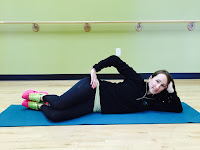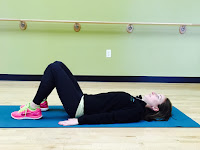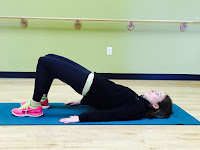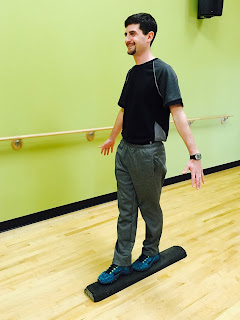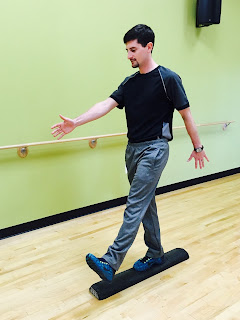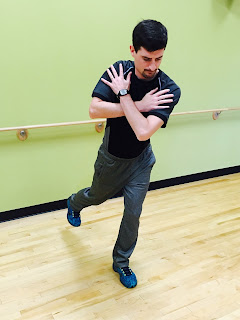3 Glute Exercises to Improve your Golf Game
The Titleist
Performance Institute (TPI) calls the glutes the “King of the Golf Swing.” Why?
Performance Institute (TPI) calls the glutes the “King of the Golf Swing.” Why?
Your glutes
play a very important role in the golf swing.
Two words: Power and consistency.
play a very important role in the golf swing.
Two words: Power and consistency.
One of the
main roles of the glutes is to stabilize the hips. In the golf swing you generate power from the
ground up. To maintain power throughout
the backswing, your glutes must maintain pelvic stability as you internally
rotate on the back leg and your upper body rotates. Stability is also important to allow rotation
in the downstwing and the follow through.
If you’re lacking stability, your consistency will suffer and it could
even lead to some swaying and sliding swing characteristics.
main roles of the glutes is to stabilize the hips. In the golf swing you generate power from the
ground up. To maintain power throughout
the backswing, your glutes must maintain pelvic stability as you internally
rotate on the back leg and your upper body rotates. Stability is also important to allow rotation
in the downstwing and the follow through.
If you’re lacking stability, your consistency will suffer and it could
even lead to some swaying and sliding swing characteristics.
If your glutes
are not firing properly, other muscles may compensate and could also lead to
overuse injuries of the hamstrings and lower back.
are not firing properly, other muscles may compensate and could also lead to
overuse injuries of the hamstrings and lower back.
Strengthen your glutes for more power and consistency! Here are 3 glute exercises to try…
Clamshell
What: Glute
Medius, Hip External Rotation
Medius, Hip External Rotation
How: Lay on
your side with your knees bent and your legs stacked on top of each other. Keep your feet together and lift your top
knee as far as possible without rocking.
I like to suggest putting your hand on your hip so you can feel any
rocking. Try 2 sets of 10 repetitions
then repeat on the other side.
your side with your knees bent and your legs stacked on top of each other. Keep your feet together and lift your top
knee as far as possible without rocking.
I like to suggest putting your hand on your hip so you can feel any
rocking. Try 2 sets of 10 repetitions
then repeat on the other side.
Reverse Clamshell
What: Hip Internal
Rotation
Rotation
How: Lay on
your side with your knees bent and your legs stacked on top of each other. Keep your knees together and lift your top
foot as far as possible. Try 2 sets of
10 repetitions then repeat on the other side.
your side with your knees bent and your legs stacked on top of each other. Keep your knees together and lift your top
foot as far as possible. Try 2 sets of
10 repetitions then repeat on the other side.
Bridge
What: Glutes
How: Lay on
your back with your knees bent and your feet flat on the ground. Lift your hips off the ground. Hold for 1-2 seconds then lower. Try 2 sets of 10 repetitions and focus on
using your glutes. If you feel your
hamstrings, your glutes are not firing correctly!
your back with your knees bent and your feet flat on the ground. Lift your hips off the ground. Hold for 1-2 seconds then lower. Try 2 sets of 10 repetitions and focus on
using your glutes. If you feel your
hamstrings, your glutes are not firing correctly!
Blog post by Jen Skiba.
Balance & Stability Training for Golfers
Balance is the ability to maintain
center of gravity when external forces are placed on it.
center of gravity when external forces are placed on it.
Stability is the ability of any system
to remain unchanged or aligned in the presence of change or outside forces.
to remain unchanged or aligned in the presence of change or outside forces.
In golf one
must have good balance to maintain posture while moving through the golf swing
and remain stable on uneven surfaces or even in windy situations. The golf swing is a complex movement pattern
combining mobility and stability. It
requires the ankles, hips and spine to be mobile while your feet, knees and
pelvis must be stable. You can create
stability by combining balance, strength, and muscle endurance.
must have good balance to maintain posture while moving through the golf swing
and remain stable on uneven surfaces or even in windy situations. The golf swing is a complex movement pattern
combining mobility and stability. It
requires the ankles, hips and spine to be mobile while your feet, knees and
pelvis must be stable. You can create
stability by combining balance, strength, and muscle endurance.
As a
Certified Burdenko Method instructor, we learn the six essential qualities of
life and sport are balance, coordination, flexibility, endurance, speed and
strength. We must start at the bottom of
the pyramid and master balance, coordination and flexibility before moving on
to developing endurance, speed and strength.
While many people feel that balance and stability training is more
appropriate for a senior exercise program, it is very important to work on
balance to maintain postural alignment and control while developing power in
younger athletes.
Certified Burdenko Method instructor, we learn the six essential qualities of
life and sport are balance, coordination, flexibility, endurance, speed and
strength. We must start at the bottom of
the pyramid and master balance, coordination and flexibility before moving on
to developing endurance, speed and strength.
While many people feel that balance and stability training is more
appropriate for a senior exercise program, it is very important to work on
balance to maintain postural alignment and control while developing power in
younger athletes.
Why is balance so important in golf?
Just like
Burdenko, balance is the first fundamental in golf. You must maintain posture throughout your
swing while at the same time generating speed/power and stretching/contracting
adjacent segments. You a need to be able
to load on the back leg before transitioning into the downswing. Better balance means better control of the
club which means better accuracy. Maintaining
balance and posture throughout the entire swing will also help with
consistency. Isn’t that what we all
strive for?
Burdenko, balance is the first fundamental in golf. You must maintain posture throughout your
swing while at the same time generating speed/power and stretching/contracting
adjacent segments. You a need to be able
to load on the back leg before transitioning into the downswing. Better balance means better control of the
club which means better accuracy. Maintaining
balance and posture throughout the entire swing will also help with
consistency. Isn’t that what we all
strive for?
You must also
consider the surfaces you are playing on.
Golf courses are typically not flat!
You may be hitting on a hill, one foot in a bunker, or even strange foot
positions to avoid trees or other obstacles.
It’s important to stay on your feet and practicing your balance can
help.
consider the surfaces you are playing on.
Golf courses are typically not flat!
You may be hitting on a hill, one foot in a bunker, or even strange foot
positions to avoid trees or other obstacles.
It’s important to stay on your feet and practicing your balance can
help.
How do you test balance?
We test
balance with TPI’s Single Leg Balance Test.
According to TPI, “It highlights any ankle mobility or proprioceptive
imbalance from left to right as well as overall stability in the core.”
balance with TPI’s Single Leg Balance Test.
According to TPI, “It highlights any ankle mobility or proprioceptive
imbalance from left to right as well as overall stability in the core.”
Do not attempt
this test without a Certified TPI Professional.
The Single Leg Balance Test begins by standing with your arms by your
sides. Lift one leg to 90 degrees so
that your thigh is parallel to the ground.
When you’re stable and feel balanced, close your eyes. How long can you maintain balance? Any movement or repositioning of the leg/foot
would be considered a loss of balance.
this test without a Certified TPI Professional.
The Single Leg Balance Test begins by standing with your arms by your
sides. Lift one leg to 90 degrees so
that your thigh is parallel to the ground.
When you’re stable and feel balanced, close your eyes. How long can you maintain balance? Any movement or repositioning of the leg/foot
would be considered a loss of balance.
The PGA Tour standard is at least 25 seconds on each foot with your eyes
closed.
closed.
What can I do to improve
my balance?
my balance?
There
are a variety of exercises you can do to improve your balance. Balance starts to decline when we reach a
certain age so it’s important to keep working on your balance every day.
are a variety of exercises you can do to improve your balance. Balance starts to decline when we reach a
certain age so it’s important to keep working on your balance every day.
Here are 3 balance
exercises to try:
exercises to try:
1. Half Roll Tandem Stance
-Begin by standing with both feet on a
half roll with one foot in front of the other.
half roll with one foot in front of the other.
-Maintain balance as long as you can
then repeat with the leg in front.
then repeat with the leg in front.
-You can also challenge yourself by
closing your eyes.
closing your eyes.
2. Half Roll Leg Swings
-Begin by standing with one foot on a
half roll.
half roll.
-Swing your leg forwards and
backwards.
backwards.
-Keep your back straight and add in
your arms swinging opposite arm/leg.
your arms swinging opposite arm/leg.
-You can also challenge yourself by
closing your eyes.
closing your eyes.
3. Single Leg Stance with Torso Turns
-Begin in golf posture.
-Cross your arms and lift one leg off
the ground.
the ground.
-Practice maintaining balance and
lower body stability while rotating your torso side to side. Remember: slow and
controlled!
lower body stability while rotating your torso side to side. Remember: slow and
controlled!
Blog
post by Jen Skiba.
post by Jen Skiba.
Post-Round Stretches for Golfers
Do you stretch after playing golf?
Post-round stretching is just as
important as your dynamic warm up. The
goals of these static stretches are to decrease stiffness, prevent soreness and
increase golf flexibility. The muscle is
taken to a point of mild stretch and held for 20-30 seconds. Perform 2-3 repetitions of each
exercise. Do not perform any exercise
that causes or increases pain.
important as your dynamic warm up. The
goals of these static stretches are to decrease stiffness, prevent soreness and
increase golf flexibility. The muscle is
taken to a point of mild stretch and held for 20-30 seconds. Perform 2-3 repetitions of each
exercise. Do not perform any exercise
that causes or increases pain.
Standing Quad Stretch
In your left hand, hold
the club upside down with the grip end planted firmly on the ground. Stand on your left leg and grab your right
foot/ankle with your right hand. Try to
keep your right knee directly underneath you.
Hold 20-30 seconds. Repeat on the
other leg.
the club upside down with the grip end planted firmly on the ground. Stand on your left leg and grab your right
foot/ankle with your right hand. Try to
keep your right knee directly underneath you.
Hold 20-30 seconds. Repeat on the
other leg.
Standing Hamstring Stretch
Hold the club upside down
with the grip end planted firmly on the ground.
Stand on your left leg and place your right foot onto your golf cart or
another elevated stable surface. Hinge
forward into the stretch until you feel a stretch in your hamstrings. Hold 20-30 seconds. Repeat on the other leg.
with the grip end planted firmly on the ground.
Stand on your left leg and place your right foot onto your golf cart or
another elevated stable surface. Hinge
forward into the stretch until you feel a stretch in your hamstrings. Hold 20-30 seconds. Repeat on the other leg.
Bent Leg Calf Stretch
Hold the club upside down
with the grip end planted firmly on the ground.
Step back with your right foot.
Keep your right heel planted firmly on the ground and slowly bend your
back knee. Hold 20-30 seconds. Repeat with the other leg.
with the grip end planted firmly on the ground.
Step back with your right foot.
Keep your right heel planted firmly on the ground and slowly bend your
back knee. Hold 20-30 seconds. Repeat with the other leg.
Standing Figure 4 Stretch
Hold the club upside down
with the grip end planted firmly on the ground.
Cross your right leg, resting your right ankle just above the left
knee. Slowly sit back into your
imaginary chair until your feel a stretch in your piriformis.
Important: Keep your back straight, do not hunch forward. Hold 20-30 seconds. Repeat with the other leg. (Can
also be done seated.)
with the grip end planted firmly on the ground.
Cross your right leg, resting your right ankle just above the left
knee. Slowly sit back into your
imaginary chair until your feel a stretch in your piriformis.
Important: Keep your back straight, do not hunch forward. Hold 20-30 seconds. Repeat with the other leg. (Can
also be done seated.)
Standing Prayer Stretch
Hold the club upside down
with the grip end planted firmly on the ground.
You can also use your golf cart or higher stable surface. Sit back into your heels, hinging at the hips
until you feel a stretch in your shoulders and lat muscles. Hold 20-30 seconds.
with the grip end planted firmly on the ground.
You can also use your golf cart or higher stable surface. Sit back into your heels, hinging at the hips
until you feel a stretch in your shoulders and lat muscles. Hold 20-30 seconds.
Wrist Extension Stretch
Grab your right hand with
your left hand. Extend your wrist
bringing your finger nails toward your forearm until you feel a mild stretch. Slowly extend your elbow. Hold 20-30 seconds. Repeat on the other arm.
your left hand. Extend your wrist
bringing your finger nails toward your forearm until you feel a mild stretch. Slowly extend your elbow. Hold 20-30 seconds. Repeat on the other arm.
Wrist Flexion Stretch
Grab your right hand with
your left hand. Flex your wrist bringing
your finger pads towards your forearm until you feel a mild stretch. Slowly extend your elbow. Hold 20-30 seconds. Repeat on the other arm.
your left hand. Flex your wrist bringing
your finger pads towards your forearm until you feel a mild stretch. Slowly extend your elbow. Hold 20-30 seconds. Repeat on the other arm.
Blog post by Jen Skiba.
Your Desk Job could be Affecting your Golf Game
There have been numerous
studies in the past few years about the detrimental effects of sitting all
day. Some media sites have even claimed
that “Sitting is the New Smoking” because of the increased risk of disease and
even death. We know how important it is
to get in 30-60 minutes of physical activity (on most if not all days of the
week) but what you are doing the other 23 hours of your day could be offsetting
the work that you are putting in at the gym or out on the course.
studies in the past few years about the detrimental effects of sitting all
day. Some media sites have even claimed
that “Sitting is the New Smoking” because of the increased risk of disease and
even death. We know how important it is
to get in 30-60 minutes of physical activity (on most if not all days of the
week) but what you are doing the other 23 hours of your day could be offsetting
the work that you are putting in at the gym or out on the course.
In addition to an increased
risk of cardiovascular disease, sitting can cause a change in your
posture. Think about how you sit when
you are at the computer. Most of us
don’t sit up straight and tall like we should.
Spinal alignment is off as your shoulders start slouching forward
causing your chest muscles to tighten.
Soon you notice a forward head position.
Long term sitting can cause your muscles and spine to stay in these
forward bending positions even when we are standing.
risk of cardiovascular disease, sitting can cause a change in your
posture. Think about how you sit when
you are at the computer. Most of us
don’t sit up straight and tall like we should.
Spinal alignment is off as your shoulders start slouching forward
causing your chest muscles to tighten.
Soon you notice a forward head position.
Long term sitting can cause your muscles and spine to stay in these
forward bending positions even when we are standing.
In Titleist Performance
Institute (TPI) language, we call this the “C posture,” also known as Upper
Cross Syndrome or kyphosis. TPI reported that 33.1% of all amateur players have C postures which is
characterized by excessive roundness in the upper back. More specifically it is tight upper trap and
weak lower trap, tight levator scapulae, tight sternocleidomastoid, weak
serratus anterior, weak deep neck flexors, and tight pec major and pec minor. An unstable core could also lead to these C
posture characteristics.
Institute (TPI) language, we call this the “C posture,” also known as Upper
Cross Syndrome or kyphosis. TPI reported that 33.1% of all amateur players have C postures which is
characterized by excessive roundness in the upper back. More specifically it is tight upper trap and
weak lower trap, tight levator scapulae, tight sternocleidomastoid, weak
serratus anterior, weak deep neck flexors, and tight pec major and pec minor. An unstable core could also lead to these C
posture characteristics.
A golfer’s thoracic spine
needs to be mobile. Any arching of the
upper back or lack of thoracic extension can result in a loss of rotation,
specifically in the backswing. If you’re not
getting the club to the proper position in the backswing, you could be limiting
both your power and consistency.
needs to be mobile. Any arching of the
upper back or lack of thoracic extension can result in a loss of rotation,
specifically in the backswing. If you’re not
getting the club to the proper position in the backswing, you could be limiting
both your power and consistency.
The
goal in the setup position is a neutral spine but it’s not a simple fix and
these muscular imbalances need to be addressed off the course and in the gym. Find a Certified TPI
Professional in your area and schedule a golf fitness assessment. They will be your greatest resource to help
you improve your golf game.
goal in the setup position is a neutral spine but it’s not a simple fix and
these muscular imbalances need to be addressed off the course and in the gym. Find a Certified TPI
Professional in your area and schedule a golf fitness assessment. They will be your greatest resource to help
you improve your golf game.
What can you do if you
have a desk job? Get up and move! Take small breaks throughout the day and get
up and stretch, go for a drink of water or take a lap around the office. Set a timer so every 30 minutes you are
reminded it’s time to stand up.
have a desk job? Get up and move! Take small breaks throughout the day and get
up and stretch, go for a drink of water or take a lap around the office. Set a timer so every 30 minutes you are
reminded it’s time to stand up.
Remember: A neutral spine and good posture will lead to more rotation. Mobility is important for proper mechanics
and injury prevention. If you don’t take
care of your body, your longevity in the game you love may be cut short!
[Related Posts: Desk Yoga
& Desk Yoga – Part 2]
& Desk Yoga – Part 2]
Blog post by Jen Skiba.
Dynamic Golf Warm Up
Do you warm up before playing golf?
A good warm up is important for preventing injuries and preparing your body to perform. Next time you head out to the course, try these sport-specific, dynamic stretches. Warm up by walking for 3-5 minutes.
Perform 10 repetitions of each exercise. Gradually move through greater range
of motion. Do not perform any exercise that causes or increases pain.
Perform 10 repetitions of each exercise. Gradually move through greater range
of motion. Do not perform any exercise that causes or increases pain.
Crossover Pass
Hold your golf club in one
hand and extend your arm to the side. Pass the club over your head to the other
hand. Extend the other arm. Follow the exchange with your head.
hand and extend your arm to the side. Pass the club over your head to the other
hand. Extend the other arm. Follow the exchange with your head.
Side Bending
Hold your golf club in
both hands over your head. Bend to one
side. Return to original position. Bend to the other side.
both hands over your head. Bend to one
side. Return to original position. Bend to the other side.
Front Bending
Stand with your golf clubs
behind your back in both hands with your arms shoulder width apart. Bend
forward and lift your arms over your back.
behind your back in both hands with your arms shoulder width apart. Bend
forward and lift your arms over your back.
Around the Body
Hold your golf club in
both hands as wide as possible. Rotate the club around your head clockwise. Repeat
counterclockwise.
both hands as wide as possible. Rotate the club around your head clockwise. Repeat
counterclockwise.
Hip Rotation
Hold the club upside down
with the grip end planted firmly on the ground. Stabilize your upper body and rotate
your hips. (Remember: We want rotary motion, not lateral!)
with the grip end planted firmly on the ground. Stabilize your upper body and rotate
your hips. (Remember: We want rotary motion, not lateral!)
Squat and Twist
Hold your golf club in
both hands and extend your arms straight in front of your body. Squat and turn
your hands so that your right hand is on top and left hand is on bottom. Return
to standing. Repeat with the left hand on top.
both hands and extend your arms straight in front of your body. Squat and turn
your hands so that your right hand is on top and left hand is on bottom. Return
to standing. Repeat with the left hand on top.
Golf Swing Twist
Hold your golf club in
both hands and extend your arms straight in front of your body. Continue to
hold the club in front of you and twist your body side to side as if your lower
body was going through the golf swing.
both hands and extend your arms straight in front of your body. Continue to
hold the club in front of you and twist your body side to side as if your lower
body was going through the golf swing.
Step
and Turn
Place
your golf club on your shoulders, holding onto it with both hands. Step forward
with your left leg into a lunge and rotate your upper body to the left. Return
to the starting position. Repeat to the other side.
your golf club on your shoulders, holding onto it with both hands. Step forward
with your left leg into a lunge and rotate your upper body to the left. Return
to the starting position. Repeat to the other side.
Leg Swings (2 Directions)
Hold the club upside down
with the grip end planted firmly on the ground. Stand on your left leg and
swing your right leg front and back. Repeat on the other leg. Then perform the
same exercise swinging your leg left to right, crossing in front of your
stabilizing leg. Repeat on the other leg.
with the grip end planted firmly on the ground. Stand on your left leg and
swing your right leg front and back. Repeat on the other leg. Then perform the
same exercise swinging your leg left to right, crossing in front of your
stabilizing leg. Repeat on the other leg.
For a
more personalized warm up routine, schedule your Golf Fitness Assessment with
one of our TPI Certified Professionals: https://www.capecodrehab.com/golf-fitness-program/
Blog post by Jen Skiba.

